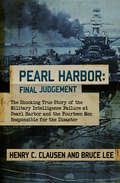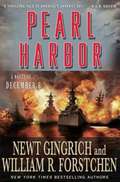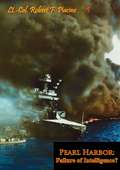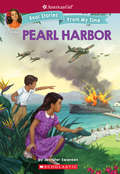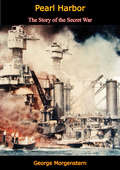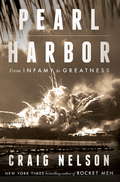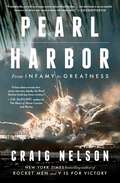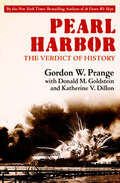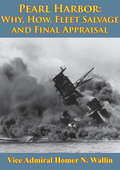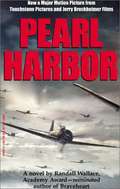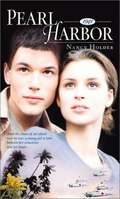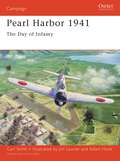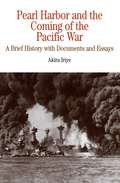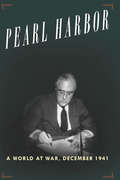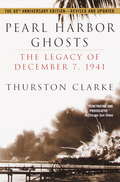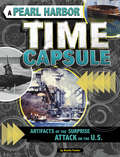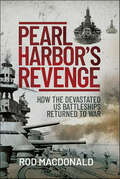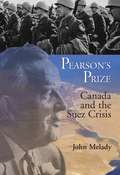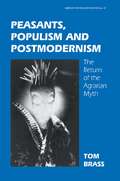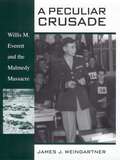- Table View
- List View
Pearl Harbor: Final Judgement
by Henry C. Clausen Bruce Lee"We might have possessed the genius to break the Purple code, but in 1941 we didn't have the brains to know what to do with it." --Henry C. Clausen, special investigator for secretary of war Henry L. Stimson On December 6, 1941, Admiral Husband E. Kimmel, commander in chief of the United States Pacific Fleet, assured his staff that the Japanese would not attack Pearl Harbor. The next morning, Japanese carriers steamed toward Hawaii to launch one of the most devastating surprise attacks in the history of war, proving the admiral disastrously wrong. Immediately, an investigation began into how the American military could have been caught so unaware. The results of the initial investigation failed to implicate who was responsible for this intelligence debacle. Secretary of War Henry L. Stimson, realizing that high-ranking members of the military had provided false testimony, decided to reopen the investigation by bringing in an unknown major by the name of Henry C. Clausen. Over the course of ten months, from November 1944 to September 1945, Clausen led an exhaustive investigation. He logged more than fifty-five thousand miles and interviewed over one hundred military and civilian personnel, ultimately producing an eight-hundred-page report that brought new evidence to light. Clausen left no stone unturned in his dogged effort to determine who was truly responsible for the disaster at Pearl Harbor. Pearl Harbor: Final Judgement reveals all of the eye-opening details of Clausen's investigation and is a damning account of massive intelligence failure. To this day, the story surrounding the Japanese attack on Pearl Harbor stokes controversy and conspiracy theories. This book provides conclusive evidence that shows how the US military missed so many signals and how it could have avoided the events of that fateful day.
Pearl Harbor: A Novel of December 8th (Book One of the Pacific War series)
by Newt Gingrich William R. ForstchenHow could the presence of 1 more man in the Japanese force have changed the Pearl Harbor attack and subsequent war? Alternate historical fiction.
Pearl Harbor
by Deborah HopkinsonDescribes the Japanese attack on Pearl Harbor in 1941 and its aftermath.
Pearl Harbor: Failure of Intelligence?
by Lt.-Col. Robert F. PiacineMany scholars and writers state that the surprise the Japanese achieved in their attack on Pearl Harbor resulted from a failure of the U.S. intelligence community to provide adequate, accurate information to government and military decision-makers. These historians presume the intelligence community possessed critical information that was misinterpreted or not appropriately disseminated prior to the attack. Some revisionist historians also subscribe to conspiracy theories and believe that key members of the U.S. government purposely withheld this critical information from the military command in an effort to bring the U.S. into World War II against the Axis powers....A review of the evidence available from official, public, and private sources, however, indicates these viewpoints are inaccurate. At best they reflect a lack of understanding of the collection capabilities and information available to the U.S. intelligence community before Pearl Harbor; at worst these views are an effort to rewrite history. It is possible to disprove these allegations, however, by examining the history of the U.S. intelligence community prior to the attack; its intelligence collection capabilities; the success or failure of the collection effort; its knowledge of Japanese military preparations for offensive activity; and the utilization of that information by national and military decision-makers.The lessons of Pearl Harbor are too valuable to be lost to misinterpretation or revisionism. They provide the basis for teaching future generations of government and military leaders the importance of national preparedness and the proper use of intelligence. Without a clear understanding, future leaders may be doomed to repeat the mistakes of the past--an error of major proportions during this time of military downsizing and decreasing power projection capabilities.
Pearl Harbor (American Girl: Real Stories From My Time #4)
by Kelley McMorris Jennifer SwansonDiscover the stories of the real people and events that shaped American history in the Real Stories From My Time series. Perfect for book reports with full-page illustrations throughout, these nonfiction chapter books also include historical photos, maps, a timeline, a glossary, and a bibliography at the back. Plus, in each book, an American Girl historical character shares a bit of her own fictional story. Pearl Harbor features real stories of that fateful Sunday morning in 1941 when Japanese planes executed a surprise attack on the American base at Pearl Harbor in Hawaii. American Girl Nanea Mitchell shares her own experiences adjusting to the drastic changes to everyday life in Hawaii following the attack.
Pearl Harbor: The Story of the Secret War
by George MorgensternFirst published in 1947, Pearl Harbor: The Story of the Secret War is widely regarded as the first Revisionist book about the attack on Pearl Harbor on December 7, 1941, and the complex history which preceded and followed it.Although it drew both criticism and praise on its initial release, this book covers many aspects of that war, its antecedents and its consequences, and ranks among the best of the numerous volumes published on the subject.“Those who object to historical skepticism may complain that my book is no contribution to the political canonization of its central figure. That is no concern of mine. As to the purpose my book is intended to serve, some observations from the minority report of the Joint Congressional Committee which investigated the Pearl Harbor attack are pertinent: ‘In the future the people and their Congress must know how close American diplomacy is moving to war so that they may check in advance if imprudent and support its position if sound ... How to avoid war and how to turn war -- if it finally comes -- to serve the cause of human progress is the challenge to diplomacy today as yesterday.’“—George Morgenstern
Pearl Harbor: From Infamy to Greatness
by Craig NelsonOn 7 December 1941, an armada of 354 Japanese warplanes launched a surprise attack on the United States, killing 2,403 people and forcing America's entry into the Second World War. With vivid prose and astonishing detail, Craig Nelson combines thrilling historical drama with individual concerns and experiences, following an ensemble of sailors, soldiers, pilots, diplomats, admirals, generals, the emperor and the president.Unmatched in breadth and depth, Pearl Harbor: From Infamy to Greatness in a portrait of the terror, chaos, violence and tragedy of the attack that would prove to be a turning point of the war.
Pearl Harbor: From Infamy to Greatness
by Craig NelsonPublished in time for the 75th anniversary, a gripping and definitive account of the event that changed twentieth-century America--Pearl Harbor--based on years of research and new information uncovered by a New York Times bestselling author.The America we live in today was born, not on July 4, 1776, but on December 7, 1941, when an armada of 354 Japanese warplanes supported by aircraft carriers, destroyers, and midget submarines suddenly and savagely attacked the United States, killing 2,403 men--and forced America's entry into World War II. Pearl Harbor: From Infamy to Greatness follows, moment by moment, the sailors, soldiers, pilots, diplomats, admirals, generals, emperor, and president as they engineer, fight, and react to this stunningly dramatic moment in world history. Beginning in 1914, bestselling author Craig Nelson maps the road to war, beginning with Franklin D. Roosevelt, then the Assistant Secretary of the Navy (and not yet afflicted with polio), attending the laying of the keel of the USS Arizona at the Brooklyn Navy Yard. Writing with vivid intimacy, Nelson traces Japan's leaders as they lurch into ultranationalist fascism, which culminates in their insanely daring yet militarily brilliant scheme to terrify America with one of the boldest attacks ever waged. Within seconds, the country would never be the same. In addition to learning the little understood history of how and why Japan attacked Hawaii, we hear an abandoned record player endlessly repeating "Sunrise Serenade" as bombs shatter the decks of the California; we feel cold terror as lanky young American sailors must anxiously choose between staying aboard their sinking ships or diving overboard into harbor waters aflame with burning ship fuel; we watch as Navy wives tearfully hide with their children in caves from a rumored invasion, and we understand the frustration and triumph of a lone American teenager as he shoots down a Japanese bomber, even as the attack destroys hundreds of US airplanes and dozens of ships. Backed by a research team's five years of work, which produced nearly a million pages of documents, as well as Nelson's thorough re-examination of the original evidence assembled by federal investigators, this page-turning and definitive work provides a thrilling blow-by-blow account from both the Japanese and American perspectives, and is historical drama on the grandest scale. Nelson delivers all the terror, chaos, violence, tragedy, and heroism of the attack in stunning detail, and offers surprising conclusions about the tragedy's unforeseen and resonant consequences that linger even today.
Pearl Harbor: The Verdict of History
by Gordon W. Prange Donald M. Goldstein Katherine V. DillonThe New York Times–bestselling authors of Miracle at Midway delve into the surprise attack on Pearl Harbor during WWII in &“a superb work of history&” (Albuquerque Journal Magazine). In the predawn hours of December 7, 1941, a Japanese carrier group sailed toward Hawaii. A few minutes before 8:00 a.m., they received the order to rain death on the American base at Pearl Harbor, sinking dozens of ships, destroying hundreds of airplanes, and taking the lives of over two thousand servicemen. The carnage lasted only two hours, but more than seventy years later, terrible questions remain unanswered. How did the Japanese slip past the American radar? Why were the Hawaiian defense forces so woefully underprepared? What, if anything, did American intelligence know before the first Japanese pilot shouted &“Tora! Tora! Tora!&”? In this incomparable volume, Pearl Harbor experts Gordon W. Prange, Donald M. Goldstein, and Katherine V. Dillon tackle dozens of thorny issues in an attempt to determine who was at fault for one of the most shocking military disasters in history.
Pearl Harbor: The Verdict of History (The\warriors Ser.)
by Gordon W. Prange Donald M. Goldstein Katherine V. DillonThe New York Times–bestselling authors of Miracle at Midway delve into the surprise attack on Pearl Harbor during WWII in &“a superb work of history&” (Albuquerque Journal Magazine). In the predawn hours of December 7, 1941, a Japanese carrier group sailed toward Hawaii. A few minutes before 8:00 a.m., they received the order to rain death on the American base at Pearl Harbor, sinking dozens of ships, destroying hundreds of airplanes, and taking the lives of over two thousand servicemen. The carnage lasted only two hours, but more than seventy years later, terrible questions remain unanswered. How did the Japanese slip past the American radar? Why were the Hawaiian defense forces so woefully underprepared? What, if anything, did American intelligence know before the first Japanese pilot shouted &“Tora! Tora! Tora!&”? In this incomparable volume, Pearl Harbor experts Gordon W. Prange, Donald M. Goldstein, and Katherine V. Dillon tackle dozens of thorny issues in an attempt to determine who was at fault for one of the most shocking military disasters in history.
Pearl Harbor: Why, How, Fleet Salvage And Final Appraisal (Illustrated Edition)
by Vice Admiral Homer N. Wallin Rear Admiral Ernest McNeill Eller USN<P>Illustrated with more than 50 photos. <P>Pearl Harbor will long stand out in men's minds as an example of the results of basic unpreparedness of a peace loving nation, of highly efficient treacherous surprise attack and of the resulting unification of America into a single tidal wave of purpose to victory. Therefore, all will be interested in this unique narrative by Admiral Wallin. <P>The Navy has long needed a succinct account of the salvage operations at Pearl Harbor that miraculously resurrected what appeared to be a forever shattered fleet. Admiral Wallin agreed to undertake the job. He was exactly the right man for it - in talent, in perception, and in experience. He had served intimately with Admiral Nimitz and with Admiral Halsey in the South Pacific, has commanded three different Navy Yards, and was a highly successful Chief of the Bureau of Ships. <P>On 7 December 1941 the then Captain Wallin was serving at Pearl Harbor. He witnessed the events of that shattering and unifying "Day of Infamy." His mind began to race at high speeds at once on the problems and means of getting the broken fleet back into service for its giant task. Unless the United States regained control of the sea, even greater disaster loomed. Without victory at sea, tyranny soon would surely rule all Asia and Europe. In a matter of time it would surely rule the Americas. <P>Captain Wallin salvaged most of the broken Pearl Harbor fleet that went on to figure prominently in the United States Navy's victory. So the account he masterfully tells covers what he masterfully accomplished. The United States owes him an unpayable debt for this high service among many others in his long career.
Pearl Harbor
by Randall WallacePearl Harbor is a beautifully written and suspenseful epic saga of love and war. Rafe McCawley and Danny Walker are two daring young pilots in the U. S. Army Air Corps who have grown up like brothers and first learned to fly in crop-dusting planes. Rafe has fallen in love with Evelyn Stewart, a beautiful and courageous nurse serving in the U. S. Navy. But they are soon separated by war when Rafe volunteers for the Eagle Squadron, a group of Americans fighting alongside the English during the Battle of Britain. With the solemn promise that he will return, Rafe heads off for the deadly skies above the English Channel, while both Evelyn and Danny are transferred to the paradise of Hawaiis Pearl Harbor. Their Eden is shattered, however, when word reaches them in the Pacific that Rafe has been killed in combat. Grief-stricken, they hold fast to each other for support, and ultimately fall in love. Then Rafe returns. . . .
Pearl Harbor 1941
by Nancy HolderWhen 20-year-old Bekah Martin completes her nurse's training in San Francisco, her aunt begs her not to return to her sheltered life on the Hawaiian Islands.
Pearl Harbor 1941
by Carl Smith Jim LaurierDecember 7, 1941 was one of the single most decisive days of World War II (1939-1945) - the day that brought the USA into the fight. Six Japanese aircraft carriers disgorged their full complements in two waves on the superior US Pacific Fleet as it lay slumbering in Pearl Harbor. Depending on opposing viewpoints, the attack was either a brilliant maneuver of audacious strategy, or a piece of unparalleled villainy and deception by a supposedly friendly power. This revised edition, containing the latest research on the events of December 7, 1941, reveals several previously unknown aspects of the attack and dispels key myths that have been built up around the fateful day - a day, as Franklin Delano Roosevelt declared, that would "live in infamy".
Pearl Harbor and the Coming of the Pacific War: A Brief History With Documents And Essays (The Bedford Series In History And Culture)
by Akira IriyeAssembling more than 30 primary documents — including proposals, memoranda, decrypted messages, and imperial conferences — Iriye presents diplomatic exchanges from both American and Japanese perspectives to determine how and why the United States and Japan went to war in 1941. <P><P>A detailed introduction provides background on Japanese aggression in China and Southeast Asia during the 1930s and economic unrest and isolationism in the United States. <P><P>Readings add an interpretive dimension, placing Pearl Harbor in global context; essays from American, Japanese, Chinese, Soviet, German, British, and Indonesian perspectives explain how various countries applied pressure, offered assistance, exacerbated rifts, and significantly affected negotiations and Japan’s ultimate decision for war.
Pearl Harbor Child: A Child's View Of Pearl Harbor from Attack to Peace
by Dorinda M. NicholsonA personal account of life in Hawaii during World War II. The author was six years old when Pearl Harbor was attacked. She describes watching the attack from her front lawn, as well as the fear, paranoia, and excitement in the years that followed.
Pearl Harbor Christmas: A World at War, December 1941
by Stanley WeintraubWeintraub, a historian, author, and retired professor of arts and humanities at Penn State U. , recounts the events following the attack on Pearl Harbor from December 22, 1941, to January 1, 1942. Even though President Franklin Roosevelt wanted time to prepare the nation, British Prime Minister Winston Churchill came to the White House to discuss strategy on December 22. Weintraub traces each day of discussions between the two leaders, as well as events occurring at the time in Japan and Europe and the meetings of the leaders with foreign envoys, including one that led to the declaration initiating the United Nations. Annotation ©2011 Book News, Inc. , Portland, OR (booknews. com)
Pearl Harbor Ghosts: The Legacy of December 7, 1941
by Thurston ClarkeA landmark book published to rave reviews a decade ago, Pearl Harbor Ghosts has now been updated to commemorate the 60th anniversary of the surprise attack that forever changed the course of history. Full of gripping drama and vibrant details, here is the intimate human story of the events surrounding that fateful day of December 7, 1941--the glamorous tropical city that seemed too beautiful to suffer devastation ... the stunned naval personnel whose lives would permanently be divided into before and after Pearl Harbor ... the ordinary Honolulu residents who were tragically unprepared to be the first target in the Pacific war ... the Japanese pilots who manned the squadron of deadly silver bombers ... and the island's community of Japanese-Americans whose lives would never be the same again. Blending meticulous historic recreation with lively reporting, Clarke counterpoints the freeze-frame nightmare of the 1941 bombing with the disturbing realities of present-day Honolulu, where hundreds of veterans, both American and Japanese, converge each year to relive every hour of the attack. Wealthy Waikiki landowners and native Hawaiian farmers, admirals and nurses, Navy wives and government officials--all take their part in Clarke's rich tapestry of memory and insight. In the end, Pearl Harbor emerges as a trauma that spread from Oahu to engulf the nation and the world-an event that continues to reverberate in the lives of all who experienced it.
Pearl Harbor Is Burning: A Story of World War II (Once Upon America Series)
by Kathleen V. KudlinskiFrank wishes his family had never moved to Hawaii. He has no friends and the local boys taunt him as a haoli , an outsider. When Kenji, a Japanese-American boy, offers friendship, they discover a lot in common, especially a love of baseball. The two boys are in Frank's tree house overlooking Pearl Harbor on December 7, 1941, where they watch with fascination and horror as ship after ship is blown up in the water. Conflicting messages and rumors being broadcast over the radio serve as a background for confusion as people react to the emergency. An effective snapshot of the past, this book presents a realistic picture of what residents of Honolulu experienced on that fateful day.
Pearl Harbor Is Burning!: A Story Of World War II
by Kathleen V. Kudlinski Ronald HimlerIt is 1941, and Frank moves to Hawaii and makes friends with Kenji, a Japanese American boy. Can Kenji and Frank be friends during the war between America and Japan?
A Pearl Harbor Time Capsule: Artifacts of the Surprise Attack on the U.S. (Time Capsule History)
by Natalie FowlerA Japanese war map, a collection of U.S. military uniforms, and a gas mask are all part of the story of Japan's surprise attack on Pearl Harbor on December 7, 1941. By examining artifacts and primary sources like these, readers are drawn into the event that brought the United States into World War II. Part of the Time Capsule History series, this book examines artifacts of the Pearl Harbor attack and its aftermath. Open this imaginary time capsule and learn!
Pearl Harbor’s Revenge: How the Devastated U.S. Battleships Returned to War
by Rod Macdonald"...informative and detailed with some interesting and little-known anecdotes as well." — National Maritime Historical Society.Early on Sunday, 7 December 1941, Japanese carrier-borne aircraft launched a surprise attack against the US Pacific Fleet based at Pearl Harbor. It was a date that President Roosevelt declared “will live in infamy”. During the strike, Japanese planes attacked the seven US battleships lined up in Battleship Row – and the flag battleship USS Pennsylvania, in drydock for overhaul. The battleship USS Arizona exploded from a bomb hit at the forward magazine killing 1,177 officers and men. On USS Oklahoma, 429 men were killed – many trapped inside as the great battleship capsized after aerial torpedo strikes. USS West Virginia, meanwhile, was hit by at least seven torpedoes and several bombs, and engulfed in flames; she settled onto the bottom on an even keel. USS California was hit by a pair of torpedoes and a bomb, flooding slowly, she too settled on the bottom. The other four battleships present were more lightly damaged, with the crippled Nevada, the only battleship to get underway during the attack, being successfully beached. By the time the assault was over, eight battleships, three light cruisers, three destroyers, a training ship and other smaller vessels had been sunk or damaged. Hundreds of US aircraft had been damaged or destroyed, while 2,403 Americans had been killed. Within a week of the Japanese attack, a great salvage organization had been formed. Very quickly the lightly damaged battleships Pennsylvania, Maryland and Tennessee had been repaired in naval yards and put back into service to protect the west coast of the USA. Of the eight battleships attacked, all but Arizona were raised, temporarily patched-up and sent back to naval yards on the west coast of America for final repair and modernization. Main battery guns and ordnance were recovered from the wrecked Arizona, which would then be left to rest on the bottom of the harbor for eternity – as a memorial to the events of that fateful December day. USS Nevada was lifted off the bottom in February 1942, California in March 1942 and West Virginia in June 1942. The capsized Oklahoma, while eventually parbuckled and raised, was found to be too badly damaged to be fully rebuilt. Six of the eight battleships would thus return to service, with improved protection against bombs and torpedoes and being fitted with the latest anti-aircraft and gunnery systems. They would re-enter to the war to wreak a terrible revenge – making their presence felt during the reconquest of the Aleutian Islands and the Philippines, and the great battles of Leyte Gulf, Iwo Jima and Okinawa. Nevada would go on Atlantic convoy duty before bombarding German positions off Utah beach as the D-Day Normandy landings began. This is the story of those six.
Pearson's Prize
by John MeladyIn the fall of 1956, the world was on the brink of war. Egyptian President Gamel Nasser nationalized the Suez Canal, and Britain, France, and Israel attacked him. Russia supported Nasser, and Soviet Premier Khrushchev threatened nuclear holocaust if the United States became militarily involved. Soon, the matter became a major problem for the United Nations.Fortunately, because of the efforts of Lester Pearson, then Canada’s Minister of External Affairs, the crisis was defused. Pearson proposed a U.N. peacekeeping force be sent to Egypt to separate the warring factions there and keep the peace. Because his idea was adopted, Pearson helped save the world from war. For his outstanding statesmanship, Pearson won the Nobel Prize for Peace, the only Canadian ever to do so. This book, written to commemorate the fiftieth anniversary of the event, is about the Suez and about Pearson’s work during a tension-filled time in the twentieth century.
Peasants, Populism and Postmodernism: The Return of the Agrarian Myth
by Dr Tom BrassTracing the way in which the agrarian myth has emerged and re-emerged over the past century in ideology shared by populism, postmodernism and the political right, the argument in this book is that at the centre of this discourse about the cultural identity of 'otherness'/ 'difference' lies the concept of and innate 'peasant-ness'. In a variety of contextually-specific discursive forms, the 'old' populism of the 1890s and the nationalism and fascism in Europe, America and Asia during the 1920s and 1930s were all informed by the agrarian myth. The postmodern 'new' populism and the 'new' right, both of which emerged after the 1960s and consolidated during the 1990s, are also structured discursively by the agrarian myth, and with it the ideological reaffirmation of peasant essentialism.
A Peculiar Crusade: Willis M. Everett and the Malmedy Massacre
by James J. WeingartnerIn the wake of World War II, 74 members of the Nazi SS were accused of a war crime--soon to be known as the Malmedy Massacre--in which a large number of American prisoners of war were murdered during the Battle of the Bulge. All of the German defendants were found guilty and more than half were sentenced to death.Yet none was executed and, a decade later, all had been released from prison. This outcome resulted primarily from the dogged efforts of Willis M. Everett, Jr., a prominent Atlanta attorney who jeopardized his status as a member of the social elite to defend with great zeal and commitment the accused Germans.James Weingartner offers fresh insights into one of the most controversial episodes of World War II and in the process casts new light on the often convoluted politics of war crimes justice.
